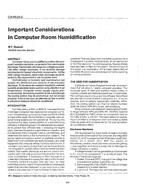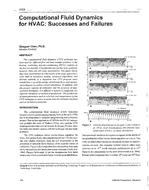Click here to purchase
Heating, Ventilation, and Air Conditioning (HVAC) systems operate at dynamic loads and may present unpredictable disturbances. Relativelyminor disturbances can greatly affect the performance of certain subsystems, such as the cooling coil control valve. The operating error of the cooling coilcontrol valve has the potential to compound with error from other subsystems and deteriorate the performance of the air handling unit (AHU). In manycases, the control systems are nonlinear and of high order, which reduces the likelihood of system stability with conventional control approaches. The objectiveof this paper is to experimentally evaluate the cooling coil control valve performance of cascade control by comparing it with a conventional Proportional-Integral (PI) control, on a nonlinear cooling coil control system. In the paper, the performances of both controls were compared first using a step change inreference input, i.e. supply air temperature setpoint step change and a step change in disturbance input, such as chilled water loop differential pressure (DP)step change. The primary testing criterion is the operating error, in terms of mean integral square error (mISE). System stability, settling time, anddisturbance rejection are also considered in the comparison of the two control approaches. As a result, the cascade control is found to be the most effectivewhen the valve system experiences pressure interruptions. For example, a maximum error of 0.46 °F for the cascade control and 0.95 °F for the single loopcontrol were observed when the DP is reduced by 5 psi (27.8% of the operation value), while the mISE in the cascade control was only 5.5% of the singleloop mISE. In addition, the mISE value of the cascade control is approximately 42% of the single loop mISE value for reference step change test.
Citation: 2020 Virtual Conference Papers
Product Details
- Published:
- 2020
- Number of Pages:
- 9
- Units of Measure:
- Dual
- File Size:
- 1 file , 1.8 MB
- Product Code(s):
- D-VC-20-C027


